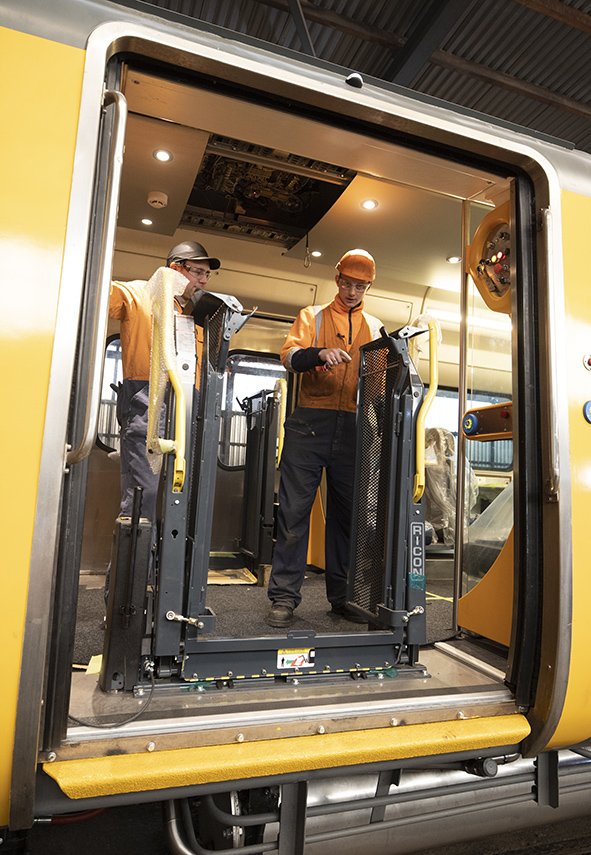Regional passenger rail
Inter-regional passenger rail offers a low-emissions, congestion free way for people to travel between some of the major cities in the North Island. KiwiRail operates two regional passenger rail services:
- Te Huia (Hamilton – Auckland) – started in April 2021
- Capital Connection (Palmerston North – Wellington) – dates back to 1991
These trains are currently focused on providing morning commuter services to Auckland and Wellington respectively, and return late afternoon services to Hamilton and Palmerston North.
Te Huia stops at Rotokauri (on the northern outskirts of Hamilton), Huntly, Papakura, Puhinui (south Auckland), and The Strand in central Auckland. Te Huia’s carriages are wifi equipped, and the train includes a café car.
The Capital Connection stops at Shannon, Levin, Ōtaki, and Waikanae before reaching its final destination at Wellington Railway Station. The Government has invested in replacing the service’s aging carriages, which will be built by KiwiRail at our Hutt Workshops. They will be similar to the Te Huia carriages, including a café car and wifi.
There are currently no inter-regional passenger services in the South Island. We are often asked why there can’t there be more services, connecting more regions and towns. The answer comes down to understanding the way passenger rail is planned and prioritised for funding.

Te Huia carriages being built at KiwiRail's Hutt Workshops.
How regional passenger rail is funded
In most countries, including New Zealand, urban commuter rail and inter-regional passenger rail services need to be subsidised by local councils and the Government. Train services are costly to run and ticket prices would be prohibitively expensive without these subsidies.
Subsidies ensure ticket prices are kept reasonable for commuters, and reflect other values that are important to local communities and central Government. As an example, trains relieve congestion on roads and have lower greenhouse gas emissions.
KiwiRail is the operator of Te Huia on behalf of the Waikato Regional Council, and operates the Capital Connection on behalf of Greater Wellington Regional Council and Horizons (Manawatū/Whanganui) Regional Council.
The relevant regional councils and Waka Kotahi both contribute to funding the two inter-regional rail services.
It’s important to note that KiwiRail’s three Scenic trains – the Northern Explorer (Auckland – Wellington), Coastal Pacific (Picton – Christchurch) and TranzAlpine (Christchurch – Greymouth) are not considered passenger trains, in the sense of simply transporting people from one destination to another. Rather, they are tourism experiences in their own right. They serve a very different role and market to passenger services, offering a slower journey with limited stops. They are about the experience of train travel, instead of the destination, and do not receive any council or Waka Kotahi funding. Ticket prices on these three trains are considerably higher than passenger services and reflect the beautiful scenery on view and the relaxed tourism experience they offer.
The future of regional passenger rail
Regional rail is a low emissions form of public transport and, given Climate Change, is seeing renewed interest.
Historically New Zealand had numerous inter-regional passenger trains in the North and South Islands, but as roading improved, car ownership increased, and with the advent of fast domestic air-travel, demand for these passenger rail services fell away.
Today, there is a clear process to consider the viability of and establish further inter-regional passenger trains in New Zealand.
The critical step is achieving support from local government and then central government.
It's a three-step process:
- Councils will need to understand the potential demand for any service, the costs required to access the carriages, locomotives and crews to operate, and the timeframes required to deliver the service. This is the business case, which we can help with. Regional rail can be expensive - Te Huia cost around $92 million to build and operate the service over five years – so understanding public demand for a new inter-regional service is crucial.
- Regions would then prioritise the new service in their Regional Land Transport Plan (RLTP), which is used by Waka Kotahi to determine regional transport initiative funding. Including a regional rail proposal in the RLTP clearly signals a new passenger rail service is ready for funding. On the other side, the Government would then consider if this should be prioritised in the New Zealand Rail Plan – a 10-year vision for rail in New Zealand to guide future investment decisions. The current NZ Rail Plan is available here.
- Once the work has occurred on the cost structures and the operational considerations, the councils and Government can then determine the funding required and work can proceed to developing the assets and readying the service. This process can take years as refurbishment of existing assets (e.g. carriages) or procuring new assets may be necessary.
The Ministry of Transport is working on guidance for local councils to assist in the planning, costing, and other considerations for establishing a new passenger rail service. Waka Kotahi, responsible for funding the Government’s contribution to these services, and KiwiRail, as an operator of these services, are involved in this work.
Inquiry into the Future of Inter-Regional Passenger Rail
Parliament’s Transport and Infrastructure Select Committee called for submissions on their inquiry by 21 October 2022. KiwiRail has submitted to the process to provide context on our role, the processes and considerations typical of any new service, and offering to assist the Select Committee as it considers submissions and prepares its report. You can read our submission here.
Photos courtesy of KiwiRail, Michael Kilgour and Waikato Regional Council
Te Huia travels between Hamilton and Auckland.

The inside of Te Huia's carriages.

New carriages for the Capital Connection were introduced in 2023. KiwiRail completely refurbished former Auckland Transport Carriages at our Hutt Workshops. The work was funded through the NZ Upgrade Programme.

The inside of the refurbished Capital Connection carriages.
